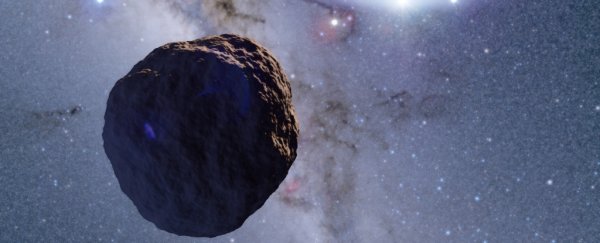For over 70 years, scientists have been predicting the existence of a certain kind of object in the outer Solar System. Small in size, these potential bodies are thought to constitute an important early step in the planet formation process.
Since these hypothetical objects are only between 1 and 10 kilometres in radius (0.6 to 6.2 miles), it's tricky to spot them from where we sit. But now astronomers think they have done it.
By staring at the sky for hours, they've obtained evidence of an object just 1.3 kilometres (0.8 miles) in radius, in the vicinity of Pluto's orbit. The find could finally be a representative of this proposed class of small, 'kilometre-sized' Kuiper Belt objects.
Given their small size and dimness, the objects can't be seen directly. So astronomers from the National Astronomical Observatory of Japan tried another method - occultation. This means essentially lying in wait and staring at a star, waiting for an object to pass in front of it and block some of its light.
They picked out 2,000 stars, and spent a total of 60 hours observing them with the help of two small, 28-centimetre (11-inch) telescopes.
The work paid off - the team found evidence of a tiny body called a planetesimal orbiting the Sun at a distance of 32 astronomical units (AU). This actually places it within Pluto's orbital range, which is between 29 and 49 AU.
This is the first time one of these planetesimals has been detected, the researchers said - and it's a marvellous feat, considering the distances involved and tools used.
"This is a real victory for little projects. Our team had less than 0.3 percent of the budget of large international projects. We didn't even have enough money to build a second dome to protect our second telescope! Yet we still managed to make a discovery that is impossible for the big projects," said NAOJ astronomer Ko Arimatsu.
We don't know for sure how planetary formation works, but according to current hypotheses, it goes a little something like this.
After a star is born, it's surrounded by a disc of leftover dust and gas swirling in its orbit. Electrostatic forces start to bind particles in this protoplanetary disc to each other, building a clump; as the clump gets bigger, its gravitational force grows too, which collects more and more particles, growing the clump even more.
We've seen these discs around other stars using radio astronomy, and even a picture of what astronomers think is a planet forming.
Here a bit closer to home, in our Solar System, the Kuiper Belt - a wide disc of rocky and ice bodies out beyond the orbit of Neptune - is thought to be a remnant of our early Solar System. It contains larger bodies, including dwarf planets such as Pluto (2,377 kilometres, or 1,477 miles) and 2014 MU69 (31 kilometres, or 19 miles).
Because they're protected by ice and far from the Sun's radiation, these bodies are thought to be time capsules, preserving the conditions of the Solar System's formation. And those objects between 1 and 10 kilometres are thought to be evidence of the point between the initial electrostatic aggregation of dust and the snowballing gravitational growth.
This discovery, using relatively cheap telescopes on a rooftop in Japan, means that it's likely these planetesimals are more abundant than previously thought - a nice piece of evidence that our planetary formation model is on the right track.
And the team isn't done yet. They have their sights on a much more distant prize.
"Now that we know our system works, we will investigate the Edgeworth-Kuiper Belt in more detail," Arimatsu said. "We also have our sights set on the still undiscovered Oort Cloud out beyond that."
The team's research has been published in the journal Nature Astronomy.
